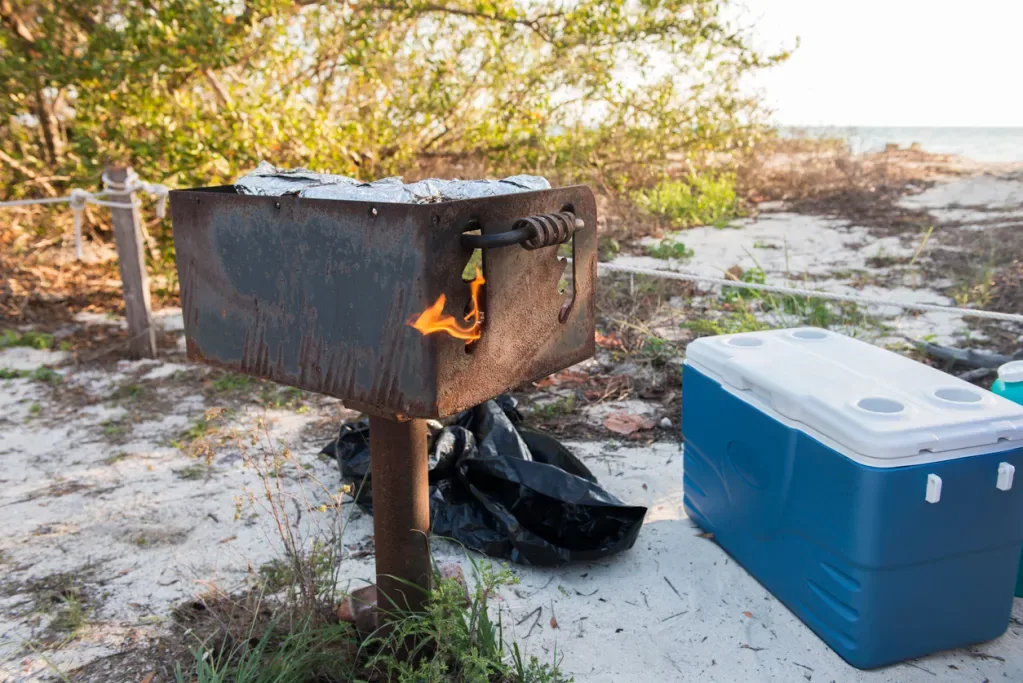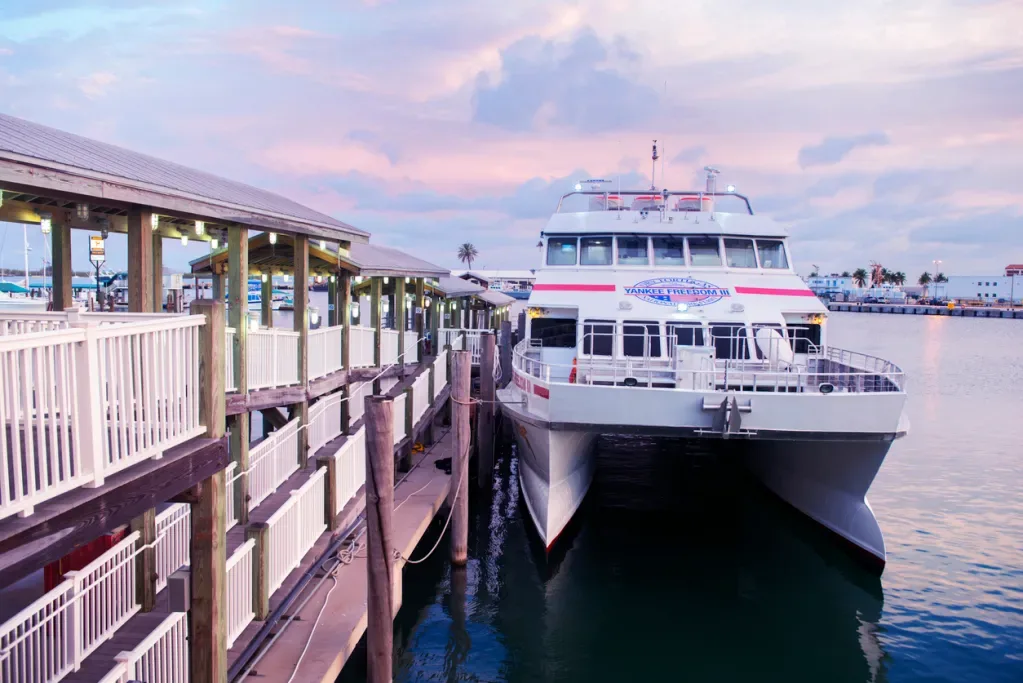You’re probably wondering why we’d ever suggest avoiding Dry Tortugas National Park. After all, it’s one of the most gorgeous places in the US.
But visiting this fantastic nature preserve comes with a unique set of challenges. Some are extreme enough that a peaceful day trip could quickly become a stressful trek.
Fortunately, there are a few things you can do ahead of time to make your trip a success.
Let’s go!
About Dry Tortugas National Park
Dry Tortugas officially became a national park in 1992. But the area already had a rich history before that point.
The seven islands compromising the archipelago are Bush, East, Garden, Hospital, Loggerhead, Long, and Middle. Spanish explorer Juan Ponce de Leon discovered the isles in the early 16th century. He nicknamed them Las Tortugas, meaning “the turtles” in Spanish.
Years later, when visitors discovered there was no source of fresh water, they were renamed Dry Tortugas.
Garden Island served as part of an Atlantic shipping route for many years. It’s also home to Fort Jefferson, a military outpost whose construction was never finished. A lighthouse was built in 1825 to warn incoming ships of the shallow water near the shore.
President Franklin D. Roosevelt declared Fort Jefferson a national monument in 1935, long before the national park existed. Today, over 80,000 people visit each year. Folks come from around the world for snorkeling, fishing, hiking, and camping.
Where Is Dry Tortugas National Park?
If you plan to visit this destination, prepare for an adventure. Dry Tortugas is only reachable by boat or seaplane, so for some folks, it’s easy to avoid. It’s about 70 miles off Key West, making the journey there a bit of a trek.
Garden Island houses the most attractions, including the fort and the lighthouse. However, due to its remote location, much of the park’s footprint consists of ocean water. While half of it is a protected research area, the other half is open to the public for fishing.
Dry Tortugas isn’t the only safeguarded area in the Florida Keys region. Two other preserves, the Florida Keys National Marine Sanctuary and the Tortugas Ecological Reserve, are nearby.
Do you know? Where Can You Eat Conch in the USA?
Why Should You Avoid Dry Tortugas National Park?
This national park is perfect for snorkeling, hiking, and learning some history. But the isolated preserve won’t be ideal for every visitor. Here are a few reasons you might want to avoid Dry Tortugas.
#1 Remote Location
The archipelago enjoys beautiful turquoise water, unspoiled white-sand beaches, and unrivaled peace and quiet. This beauty has been preserved primarily due to the chain’s remote location. Nearly 70 miles from Key West, the southernmost city in Florida, the park is closer to Cuba than Miami.
Although lack of human activity keeps the area beautiful, it’s also a huge hassle to get there. Seaplanes and boats are the only ways to travel there. Avoid Dry Tortugas if the thought of an air or sea trip makes you nervous.

#2 Limited Amenities
Most folks don’t visit national parks for the amenities. But basic conveniences like toilets and water become dearly missed when they’re unavailable. Unfortunately, this is the reality for all visitors.
Avoiding Dry Tortugas may not be a stretch when you consider there are no public bathrooms, water fountains, or food. Remember, the closest city is 70 miles away on the mainland. The infrastructure is minimal. And while the island chain’s seclusion is part of its appeal, this is one definite downside.

#3 Extreme Heat
To many, tropical sunshine and a warm coastal breeze sounds like paradise. And with an average summer temperature of 86 degrees, this national park fits the bill.
Not so fast! These temps quickly become a problem when you account for the heat index. It often feels about 15 degrees hotter than the thermometer reads. In the middle of July, when the high approaches 90 degrees, it feels more like 105.
Don’t forget that visitors must bring their own supplies, including water. If a long, hot, thirsty day doesn’t sound like your cup of tea, it’s best to avoid Dry Tortugas National Park.
Here’s a reason to visit Dry Tortugas: 5 National Parks to Avoid.
#4 Minimal Camping
Camping is wildly popular in Dry Tortugas despite limited amenities, high temps, and the islands’ remote location. Garden Key, where you’ll find Fort Johnson and the resident lighthouse, is the only spot that allows it. Overnight visitors can enjoy striking sunsets, stargazing, and sunrises.
But, like many activities there, camping is easier said than done. Sites are first-come, first-served, meaning you may not get one if you visit during popular times. And if you forget to pack something, you’re out of luck.
Avoid Dry Tortugas unless you’re willing to be highly flexible.

#5 Seasickness
No one likes motion sickness or feeling queasy. There’s nothing worse than being stuck on a boat with your stomach in knots. Unfortunately, getting to the park without getting sick can be challenging.
The ride from Key West to Garden Key isn’t exactly short. While some ferries like the Yankee Freedom have onboard systems to combat rough waves, this might not be enough to protect your tummy. Those 70 miles could be really unpleasant if you have a tough time on open water. In short, avoiding Dry Tortugas could be necessary if you’re prone to nausea.
Even if Dry Tortugas isn’t for you, the Keys are a great place to explore: Fodor’s InFocus Florida Keys.

Avoid Dry Tortugas If You’re Not Up For Adventure
This archipelago is one of the most beautiful island chains in the US. The lush flora, vibrant sea life, and pristine beaches are magical. With so much peace and quiet, you may get there and never want to leave.
However, exploring a remote place like this requires some planning. Before you take your trip, pack plenty of supplies, do some research, and prepare. But if you have any doubts, avoiding Dry Tortugas could be your wisest option!
We’ll Help You Find the Best Free Camping in the USA
You should give it a try!
As a matter of fact, these free campsites are yours to enjoy. Every time you pay federal taxes, you’re contributing to these lands.
Become a FREE CAMPING INSIDER and join the 100,000 campers who love to score the best site!
We’ll send you the 50 Best Free Campsites in the USA (one per state). Access the list by submitting your email below: